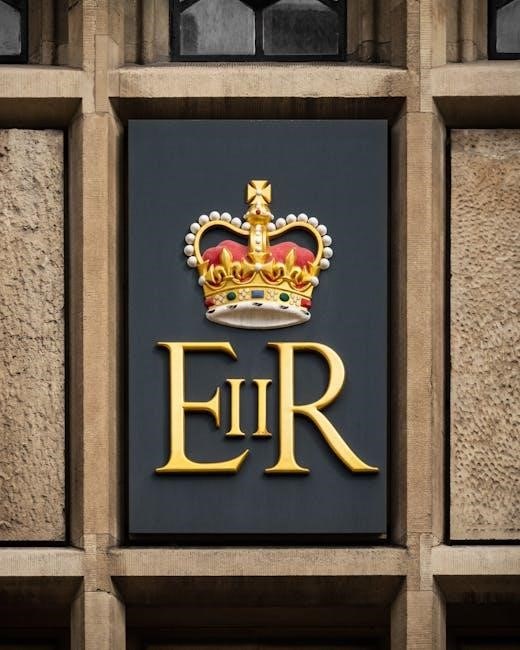Shirley Jackson’s “Charles” is a captivating short story about a young boy’s mischievous friend, exploring themes of childhood innocence and parental misunderstanding. Available as a PDF online, it remains a popular educational resource for students and teachers, offering deep insights into human behavior and perception.
Background and Publication History
Shirley Jackson’s short story “Charles” was first published in the women’s magazine Mademoiselle in 1948. It was later included in her 1949 collection, The Lottery and Other Stories. The story gained popularity for its unique narrative style and themes, becoming a staple in literary anthologies. Today, “Charles” is widely available as a PDF, with versions accessible through educational platforms like CommonLit, making it a convenient resource for teachers and students. Its enduring popularity highlights Jackson’s ability to craft compelling tales that resonate with diverse audiences.
“Charles” narrates the tale of a mother whose son, Laurie, begins kindergarten and regales her with stories of a mischievous classmate named Charles. Each day, Laurie describes Charles’s antics, from yelling during storytime to hitting another boy. The mother grows concerned, questioning whether Laurie is being influenced by a troublesome friend. As the weeks pass, Laurie’s stories about Charles become more elaborate, but the mother remains skeptical. The twist reveals that Charles is, in fact, Laurie himself, highlighting the imaginative and sometimes challenging nature of childhood. This revelation underscores the story’s themes of parental perception and reality.
Themes in “Charles”
The story explores childhood innocence, mischief, and parental perception, highlighting the gap between reality and imagination. It delves into the nature of mischievous behavior and its implications.
Childhood Innocence and Mischief
Shirley Jackson’s “Charles” masterfully explores the themes of childhood innocence and mischief through Laurie’s imaginative tales of his troublesome friend. Laurie’s stories about Charles serve as a creative outlet, blending fantasy with reality, while reflecting his own experiences and emotions. The parents’ obliviousness to Laurie’s true identity as Charles highlights the innocence of childhood and the ways children navigate their understanding of the world. The story subtly reveals how mischief can be a natural part of growing up, as children test boundaries and express themselves through imaginative narratives. This theme underscores the delicate balance between innocence and rebellion in early childhood development.
Parental Perception and Reality
In “Charles,” Shirley Jackson cleverly contrasts parental perception with reality, as Laurie’s parents initially believe Charles is a real, troublesome classmate. Their acceptance of Laurie’s tales reflects their trusting nature and the challenges of understanding childhood behavior. However, as the story progresses, subtle clues suggest that Charles may not be who he seems. The parents’ eventual realization that Laurie himself is Charles underscores the gap between their assumptions and the true nature of their son’s actions. This twist highlights how parental perception can sometimes obscure the reality of their child’s behavior, emphasizing the complexities of family dynamics and communication.
The Nature of Mischievous Behavior
In “Charles,” Laurie’s tales of his classmate’s antics reveal the nature of mischievous behavior as a form of rebellion and boundary-testing. Through Charles, Laurie expresses his own frustrations and explores the limits of acceptable conduct. Jackson portrays mischief as a natural part of childhood, driven by curiosity and a desire for attention. Laurie’s stories about Charles, filled with disruptions and defiance, highlight how children often act out to assert their individuality and navigate their environment. This behavior, while troublesome, reflects the universal struggle of growing up and understanding societal expectations, making it relatable and human.

Analysis of the Twist
The story’s shocking twist reveals that Charles is Laurie’s imaginary creation, surprising readers while cleverly aligning with earlier clues about Laurie’s behavior and stories.
Unveiling the True Identity of Charles
The true identity of Charles is revealed as none other than Laurie himself, exposing his imaginative creation to explain his mischievous behavior at school. This twist shocks both parents and readers, as Laurie’s stories about Charles were initially perceived as innocent tales. The PDF version of the story highlights how Shirley Jackson masterfully plants subtle clues throughout the narrative, such as Laurie’s consistent blame-shifting and the repeated punishments Charles endures, hinting at the reality that Charles is a reflection of Laurie’s own actions. This revelation underscores themes of childhood innocence, creativity, and parental misunderstanding, making the story a timeless classic in American literature.
Clues Throughout the Narrative
The story cleverly embeds clues that hint at the true identity of Charles. Laurie’s consistent descriptions of Charles’s misbehavior, such as yelling during story time and hitting a boy, mirror his own actions. The PDF version highlights how Laurie’s stories about Charles escalate, with Charles staying after school repeatedly, suggesting Laurie’s own troubles. The final clue comes when Laurie casually mentions, “Hi, Pop, yold dust mop,” revealing his own mischievous nature. These subtle hints prepare readers for the surprising twist, showcasing Shirley Jackson’s masterful storytelling and her ability to weave suspense into the narrative.
Laurie’s Creation of Charles
Motivations Behind the Imaginary Friend
Laurie invents Charles to attribute his misbehavior to an imaginary character, reflecting his understanding of cause and effect while creatively avoiding blame for his actions.
Laurie creates Charles as an imaginary friend to explain his misbehavior at kindergarten, attributing his actions to this troublesome character. This invention allows Laurie to explore complex emotions and experiences, blending fantasy with reality. By fabricating Charles, Laurie expresses his own feelings about school and tests his parents’ reactions, showcasing his creativity and understanding of cause-and-effect relationships. The stories about Charles reveal Laurie’s perspective on social dynamics and his attempt to navigate the challenges of growing up, making Charles a symbolic representation of his own thoughts and struggles.

Parents’ Reaction to Charles
Laurie’s parents initially believe Charles is real, concerned about his influence. They discuss kindergarten’s suitability, unaware Laurie fabricated Charles, revealing their gradual realization of the truth.
Initial Belief and Eventual Realization
Laurie’s parents initially accept Charles as a real boy, concerned about his influence on their son. They discuss whether kindergarten is suitable for Laurie, given Charles’s constant misbehavior. However, as the stories escalate, they begin to question the reality of Charles. Their eventual realization that Charles is Laurie’s imaginary creation highlights their gradual shift from belief to understanding, revealing the cleverness of Laurie’s fabrication and the parents’ growing awareness of their son’s imaginative world.
Significance of the Title
The name “Charles” symbolizes Laurie’s imaginary friend, embodying childhood innocence and mischief. The title cleverly hides the twist, reflecting the story’s subtle and layered narrative.
The Name “Charles” and Its Implications
The name “Charles” holds significant implications, serving as a symbol of Laurie’s imagination and the story’s central twist. It represents both innocence and deception, as Laurie attributes his actions to this imaginary friend. The name’s simplicity contrasts with the complexity of its role in the narrative, highlighting themes of childhood creativity and parental misunderstanding. Through “Charles,” Jackson explores how children navigate reality and fantasy, using the name to mask Laurie’s true nature. This clever use of nomenclature underscores the story’s depth, making “Charles” a memorable and thought-provoking element of the tale.

Teaching the Story
“Charles” is a valuable educational tool, offering insights into childhood behavior and parental dynamics. Its twist ending sparks critical thinking and lively classroom discussions among students.
Educational Value and Discussion Points
Shirley Jackson’s “Charles” offers significant educational value, sparking discussions on childhood behavior, imagination, and parental perceptions. The story’s twist ending encourages critical thinking and close reading, making it ideal for analyzing literary elements like foreshadowing and character development. Its themes of innocence, mischief, and reality vs. fantasy resonate with students, prompting reflections on personal experiences. The narrative’s concise structure and subtle clues provide a rich framework for teaching literary analysis, while its relatable subject matter fosters engaging classroom discussions about human behavior and the complexities of growing up.

Availability as a PDF
Shirley Jackson’s “Charles” is widely available as a PDF online, making it easily accessible for readers and educators. Its popularity ensures it can be downloaded from various educational websites and platforms, enhancing its reach and convenience for study and discussion.
Popularity and Accessibility Online
Shirley Jackson’s “Charles” is widely popular and easily accessible online, with numerous platforms offering free PDF downloads. Its frequent inclusion in educational curricula and anthologies has made it a staple for students and teachers. The story’s enduring appeal lies in its relatable themes and subtle humor, attracting readers globally. Available on sites like CommonLit and other educational resources, “Charles” can be downloaded in PDF or text format, ensuring its accessibility for classroom discussions and personal reading. Its online presence continues to grow, making it a convenient choice for literary studies and casual reading alike.
Popularity and Impact
Shirley Jackson’s “Charles” remains a beloved story, celebrated for its surprising twist and relatable themes. Its popularity endures through frequent anthologization and online availability as a PDF, making it a timeless favorite in literary studies and casual reading alike.
Cultural Reception and Influence
Shirley Jackson’s “Charles” has left a lasting impact on literary culture, celebrated for its clever twist and profound exploration of childhood and parental dynamics. The story’s enduring popularity is evident in its frequent inclusion in anthologies and its widespread use in educational settings. Its influence extends beyond literature, inspiring discussions on human behavior and perception. The tale’s ability to blend humor with deeper insights has made it a favorite among readers and scholars alike, ensuring its relevance across generations. Its availability as a PDF has further cemented its place in modern literary studies, making it accessible to a global audience.
Comparison with Other Works
Shirley Jackson’s “Charles” shares thematic ties with her other works, like “The Lottery,” both exploring human behavior and societal dynamics through subtle horror and clever twists.
Relation to Shirley Jackson’s Other Stories
Shirley Jackson’s “Charles” is a quintessential example of her mastery in blending subtle horror with everyday life, a theme prevalent in her works. Like “The Lottery,” it explores societal norms and human behavior through a veil of innocence. Both stories use ordinary settings to introduce extraordinary, often unsettling, events. “Charles” mirrors Jackson’s ability to craft relatable characters while embedding deeper psychological insights. The story’s twist ending, a hallmark of her style, keeps readers engaged and reflective, much like her other renowned tales. This connection solidifies “Charles” as a cornerstone of Jackson’s literary legacy, alongside her other iconic short stories.
Shirley Jackson’s “Charles” is a timeless tale that masterfully blends humor with psychological depth, leaving readers surprised and reflective. The story’s twist, revealing Laurie as Charles, underscores Jackson’s ability to craft relatable characters and explore complex themes. Its enduring popularity as a PDF and in classrooms highlights its educational value and cultural impact. Like her other works, “Charles” challenges readers to question perception and reality, solidifying its place as a cornerstone of American literature. The story remains a testament to Jackson’s genius in storytelling, ensuring its relevance for future generations.